How to cook the perfect chicken korma
A bland curry for the unadventurous or a noble dish worthy of Mughal emperors? Do you add fruit and nuts, is yoghurt better than cream – and would you be caught dead ordering it in a curry house?
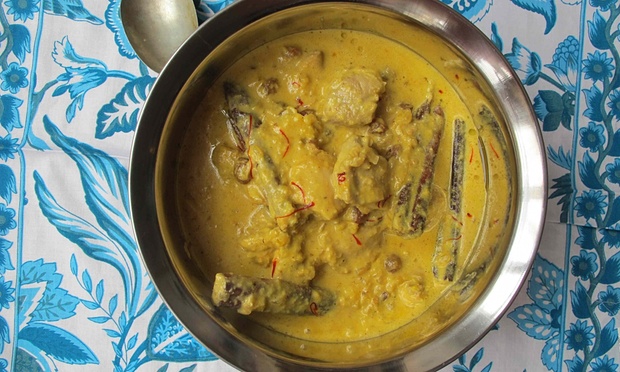
The perfect chicken korma. Photograph: Felicity Cloake/Guardian
The poor old korma would be well justified in seeking revenge on the British palate in this world or the next. A noble dish that once graced the banquet tables of the imperial Mughal court, rich with cream and nuts and heavily scented with expensive spice, has become a byword for bland, a "starter" curry, beloved of children and others with unadventurous tastes. As Lizzie Collingham writes in her book, Curry: a Biography, the name korma has become a codeword for anything "mild and creamy", just as vindaloo carries the warning sign: HOT!
And though, having grown up on them (before graduating to the spicy heights of the chicken tikka masala), I have to admit a certain residual fondness for the almost marzipan-like flavours of a classic British curry house korma, I think we're all big enough now to appreciate the more sophisticated flavours of the real deal. Which, despite my distinct lack of imperial kitchen space, proves surprisingly simple to make at home.
The chicken
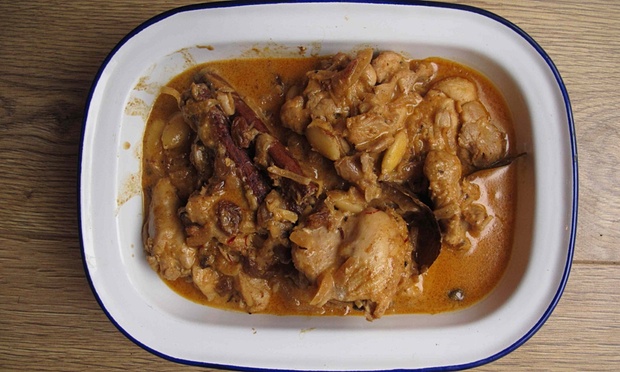
Madhur Jaffrey's chicken korma. Photograph: Felicity Cloake/Guardian
Though I find several older recipes for mutton korma, chicken seems to predominate in modern versions, which I think makes sense with such a delicate sauce. Many suggest using a whole bird, jointed, though I find that you don't get much flavour from the bones in such a brief cooking time. The boneless thighs in Madhur Jaffrey's recipe in her Curry Bible are somewhat easier to eat, as well as having a juicier texture and better flavour than chicken breast.
Dan Toombs, a Californian now living in Northallerton, who has devoted a slightly unnerving amount of his time to recreating the food of his local curry house at home (anything to distract from the British weather, I suppose), cooks his chicken breast before adding it to the sauce, writing that "the fast pace of most Indian restaurant kitchens makes in necessary to pre-cook the meat used in their curries". I find this leaves it particularly dry, however – breast is much more tender when slow-simmered, rather than sauteed in a pan.
The gravy
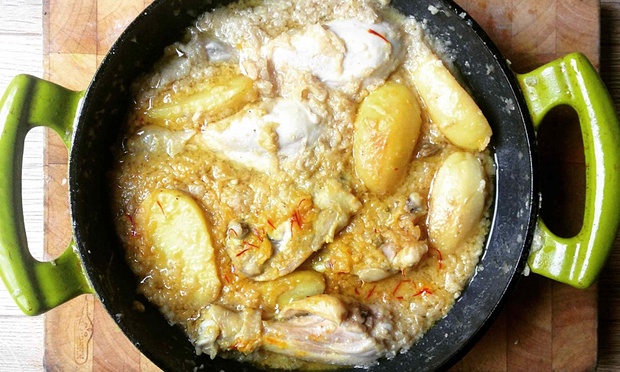
Yasmeen Murshed's chicken korma. Photograph: Felicity Cloake/Guardian
The base of every korma I make is onions – in some quantity in the case of Yasmeen Murshed's Nawab of Dhaka's family korma, which uses five onions for four people: two of them whizzed to a paste, three crisply fried then stirred into the sauce. Unsurprisingly, they're the dominant flavour in this korma, which I'm not particularly keen on because the more delicate notes of the spices and dairy get lost. A subtler preparation, flavoured with garlic and ginger, as used by Jaffrey and Gymkhana chef Karam Sethi, suits me better. Sethi also adds green chillies to the base for his Lucknawi chicken korma, which gives his sauce a slightly luminous hue. I think their sharp, herbaceous piquancy is a bit of a distraction here; I'd prefer to keep the underlying flavours simple.
Toombs's recipe is not simple. Not at all. Most of his curries start with a base sauce, which he says enables chefs to "cook, plate and serve mouthwatering curries, which would normally take much longer, very quickly. By adding different ingredients to the base curry sauce, Indian chefs can make everything from mild kormas to violently hot phall curries in no time." His sauce also involves vast numbers of onions, as well as peppers, ginger, garlic, carrot, cabbage and tomato, slow-simmered for over an hour. Once I've added dry spices, it starts to smell remarkably like a takeaway, though the final flavour is, perhaps deliberately, fairly bland. This then forms the base of his korma sauce, with other spices and flavourings added. My testers are not impressed, complaining it doesn't really taste of anything. I find it pleasantly nondescript, much like the classic korma of my childhood.
Nuts?
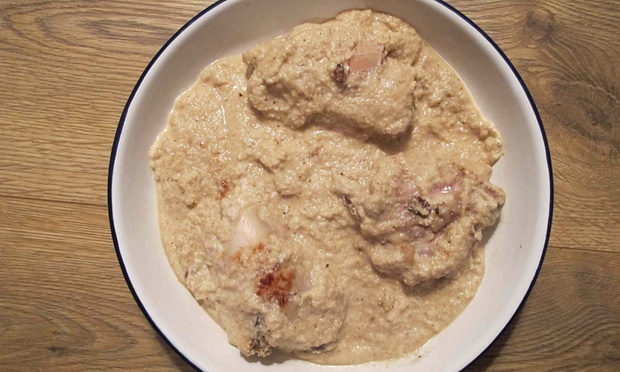
Rocky Mohan's chicken korma. Photograph: Felicity Cloake/Guardian
Most recipes, Murshed's excepted, include something sweet, rich and nutty. Rocky Mohan, whose recipe is included in Rick Stein's India, adds fresh coconut and almonds, Jaffrey uses almonds alone, Sethi and Toombs cashews, and Sethi melon seeds, which necessitate a trip down to Brick Lane, London. Coconut tastes too tropical and melon seeds, though pleasingly nutty, don't deliver the same sweetness as the cashews or the almonds. Creamier, lighter cashews have the edge for me, but feel free to substitute blanched almonds if you prefer. I've also soaked them in warm water to help them blend into the sauce more easily. Jaffrey adds her almonds whole, along with sultanas, while Mohan uses raisins. Although I'm not aware of having eaten a curry with dried fruit since the 1980s, here they work surprisingly well, contributing little pops of juicy sweetness, though it's probably not wise to overdo this.
Dairy
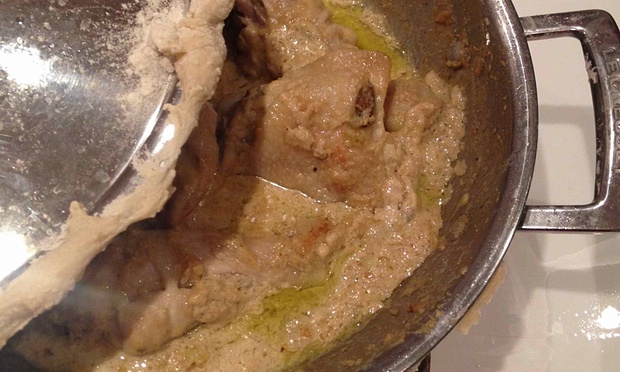
Karam Sethi's chicken korma. Photograph: Felicity Cloake/Guardian
The gravy is enriched with some sort of dairy. Mohan (or, at least, Stein) suggests Greek yoghurt thinned with water, Murshed natural yoghurt and milk, Jaffrey yoghurt and whipping cream and Toombs coconut milk and double cream. Sethi marinates his meat in yoghurt and then thins the sauce at the end with double cream. Again, coconut tastes out of place, and Greek yoghurt is too bland and thick. Tangy whole-milk yoghurt, with a touch of cream towards the end, gives the best flavour and texture; rich, but not so rich it smothers the delicate spicing. On which note …
Spices
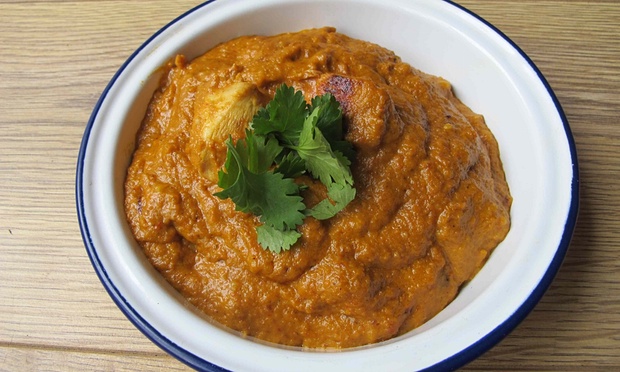
Dan Toombs's chicken korma. Photograph: Felicity Cloake/Guardian
Cardamom is the only constant of the korma recipes I try – Mohan uses the black variety as well as the green, which contributes a nice smoky note. Sweet spices are very popular, particularly cinnamon, with Mohan adding cloves, Murshed and Jaffrey saffron, and Murshed nutmeg and mace. The slightly menthol flavour of the first doesn't really float my boat, but I can't resist nutmeg and saffron – both flavours work wonderfully with chicken and dairy.
Jaffrey and Toombs use a handful of more savoury spices: coriander, cumin, garam masala and, in Toombs's case, curry powder, fenugreek, smoked paprika and turmeric, with Jaffrey also sticking in a generous amount of cayenne pepper. Her korma has a lovely flavour, but I'm inspired to keep it simple by Sethi, who describes the spicing in his mother-in-law's recipe as "subtle but indulgent". The only dry spices he includes are cardamom pods and white pepper, yet the results are richly complex and distinctively different, marking this out as a korma, rather than a generic mild curry.
Murshed adds kewra and rose water. I can't taste the former, much as I love it in other dishes, but some of the fragrance of the latter, which is also found in other recipes, does come through at the end. It gives the dish, to my fanciful mind, the perfumed whiff of a lavish Mughal banquet.
Extras
Toombs adds sugar and yellow food colouring ("optional but necessary if you want that authentic restaurant chicken korma look") to his curry, which are definitely unnecessary in an authentic Mughal version. Murshed adds potatoes, which feel a bit lumpen and rustic. Sethi recommends cooking the korma "on dum", or sealed with a flour and water paste and cooked over a very low heat so it stays moist. As he observes, a tight-fitting lid will do the trick rather less messily; if you don't have one, seal the dish well with foil before covering.
(Serves 4)-
250ml plain, full-fat yoghurt
8 skinless, boneless chicken thighs
4 tbsp double cream
1 tsp saffron threads
1 tbsp rose water
50g cashew nuts
60ml vegetable oil/4 tbsp ghee
4 cinnamon sticks
10 cardamom pods, lightly crushed
1 onion, finely chopped
6 garlic cloves, crushed
2 tbsp ginger, finely grated
¼ tsp freshly grated nutmeg
25g sultanas
1 tsp fine salt
Seeds of 1 black cardamom pod, crushed
Cut the chicken into large bite-sized chunks and marinate in half the yoghurt for at least three hours at (cool) room temperature, but preferably eight to 12 in the fridge. Take it out half an hour before you want to cook.
Heat the cream gently until warm, then take off the heat and stir in the saffron and half the rose water. Leave to infuse. Put the cashews in a small bowl with five tablespoons of warm water and leave to soak.
Heat the fat in a wide, heavy-based, lidded pan over a medium-high heat. When hot, add the cinnamon and green cardamom pods. Once the cardamom start to pop, add the chicken and brown on all sides, in batches if necessary, then lift out of the pan and set aside. Add the onion, turn down the heat slightly and fry until soft and browned, stirring regularly so it doesn't catch.
While the onions are cooking, blend the cashews and their soaking water to a smooth paste. Stir the garlic, ginger, nutmeg and sultanas into the pan and cook for a couple of minutes, then add the cashew paste and stir well. Take off the heat and stir in the remaining yoghurt and the salt. Add the chicken, along with any juices and yoghurt marinade, and bring to a simmer.
Cover tightly, turn down the heat as low as possible and simmer for about 30 minutes, until the chicken is cooked through. Stir in the cream and cook for another five minutes, then stir in the black cardamom and the remaining rose water if you think it needs it, just before serving.
Chicken korma: why is it so maligned in this country, and will anyone stand up for the British Indian restaurant version? And which other classic subcontinental dishes are better made at home?
This recipe was amended on May 19 2015 to take account of varying strengths of different brands of rosewater